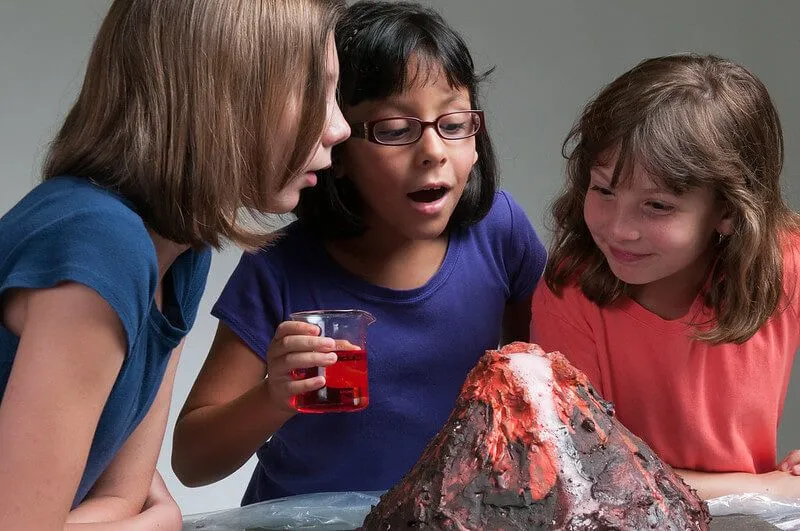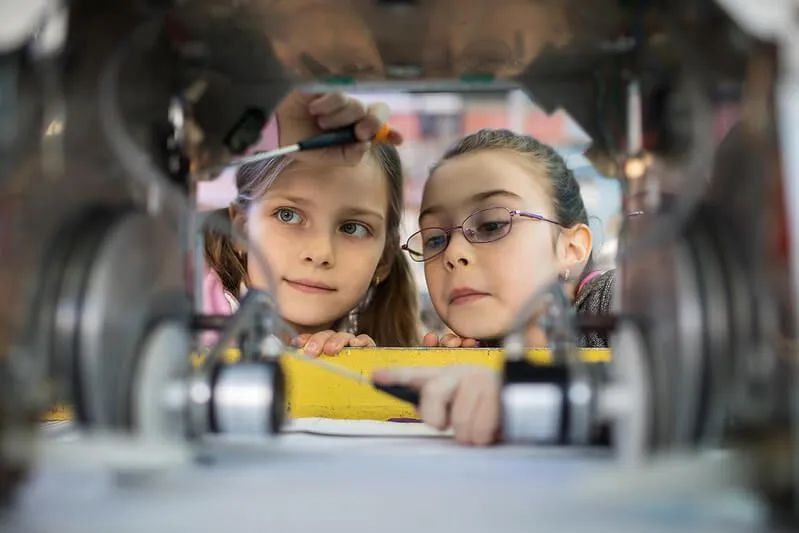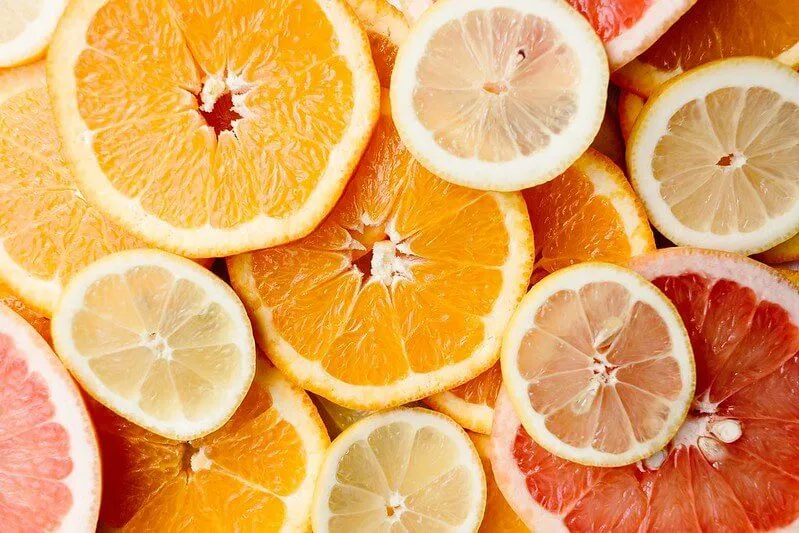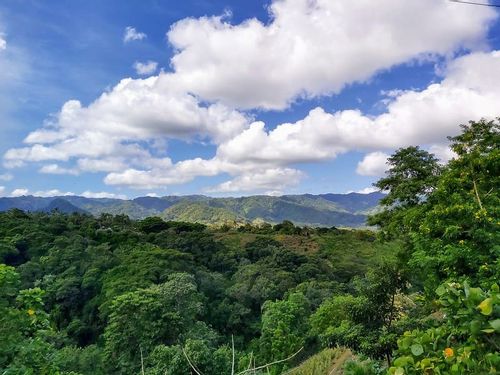FOR ALL AGES
We've got some brilliant free ideas for things to make and do that'll keep your STEM-loving kids entertained, educated and enthralled. Make fireworks in a jar, travel the world and even whip up something tasty in the kitchen. Most of these experiments and activities can be modified depending on the ages of your children, meaning you can go into more or less detail when you explain what you're doing and why. Whether your kids like building things, using technology or prefer the colourful arts and crafts side to STEM, there's something for everyone.
You'll need: jar with a lid, sand, water and washing up liquid
Fill your jar 3/4 full and add one drop of washing up liquid. Add a sprinkle of sand to your jar - this will imitate real tornadoes, which get their murky colour from all of the dirt they pick up as they travel. Tightly screw the lid onto your jar. Turn it upside down and shake it for 1-2 minutes in a circular motion. Quickly turn it back the right way up and place it onto a table or counter and you'll see your tornado build, swirl and then fade away!
You'll need: food colouring, washing up liquid, cotton buds, full-fat milk and a shallow dish
If you're trying to search for things to make and do with what you've already got at home, this activity is perfect. It might be a science experiment, but it also looks like a cool art project! Pour milk into your dish to about 1cm deep. Add drops of food colouring all over - the more colours, the better. Next, dip a cotton bud into washing up liquid and then touch the surface of the milk with it, holding it there for about 15 seconds. It'll turn into a beautiful rainbow in front of your eyes, all because of how the milk's fat molecules react to the soap!

You'll need: plastic bottle, modelling clay, 2 tbsp bicarbonate of soda, 2 tbsp washing up liquid, 1 tbsp food colouring, a splash of vinegar and a plastic dish or container
If you're hunting for ideas for scientific things to make, a DIY volcano never disappoints. Use your modelling clay to create a volcano shape around your plastic bottle before placing it into the plastic container. Add washing up liquid, food colouring and bicarbonate of soda to the bottle. To make the volcano erupt, add vinegar and watch the chemical reaction take place! If your kids are a bit older you can go into more detail and learn about how bases and acids react together and understand why the volcano reacts like this.
You'll need: access to the Internet
Improve your tech and geography skills and go on a journey with Google Earth with this free activity. Explore your house, look at previous homes you've had over the years, try to find your school, your local supermarket - anywhere. A cool twist for older kids would be to search for somewhere in the world, cover up the address on the screen with a piece of card and let them try to figure out where they are using only Google Street View, by looking at shop signs and the local landscape etc. It's a great way to teach children how to read maps and introduce them to parts of the world they've never seen!

You'll need: balloon, plastic straw, tape and a piece of string about 3-5m long
Start by tying one end of your string to a chair or other support and then thread the other end through your plastic straw. Making sure the string is taut, tie this end to another point in the room. Blow up your balloon (don't tie it) and keep pinching the end as you tape the whole thing to the straw, with the 'mouth' of the balloon facing away from the length of the string. Pull the balloon to the string's starting point, let go and watch it zoom across the room! If you've got older kids they can try out the experiment with different variables and figure out what affects the balloon's movement.
You'll need: small baking tray or casserole dish, water, food colouring, tiny toys and an eyedropper, plastic syringe or similar
This idea is an overnight craft but it'll keep the kids entertained for hours. On the first day, fill your dish with water and a few drops of your chosen food colouring. Don't use too much colouring as you don't want it to stain, and remember not to fill the dish all the way to the top as ice expands. Throw in your little toys - we recommend tiny plastic animals or Lego figurines. Put in the freezer overnight. The next day, flip the block of ice onto a baking sheet and put a hot towel on top to loosen from its container. We suggest putting a dark towel underneath anyway as the coloured water may stain light floors or tables. When the ice block is on the baking tray, let your kids add hot water to it with the dropper and watch it melt. They'll slowly be able to excavate their toys from the ice block!
You'll need: seeds or bulbs, a small shovel, a watering can, lollipop sticks and a pen
Head out to the garden and find a good spot to grow some plants. Dig a hole, plant your seeds, cover them with more soil, water them and poke lollipop sticks into the soil with the names of each plant on. Now see how long they take to grow! Use this time to teach your kids about what plants need to grow and survive, going into more detail if you have older children. Why not try planting some vegetables while you're at it? Potatoes and carrots grow well in cooler climates so who knows, maybe you'll have your own vegetable patch by the time lockdown is over!
You'll need: large jar, food colouring (multiple colours), warm water, 4 tbsp oil, a small bowl
Fill your jar 3/4 full with warm water and set aside. Add oil and a few drops of each food colouring to your bowl. Slowly mix until the colour has broken up into smaller droplets. Carefully pour this mixture on top of the water and watch as the food colouring slowly moves out of the oil and into the water. As it does it'll start to dissolve and swirl, making a watery firework explosion in the jar! This is because oil is less dense than water, and the food colouring beads are heavier than oil.

You'll need: Lego, Duplo or Sticklebricks
Looking for ideas for your mini engineers? Search online or look through some books you have at home to get inspiration for something to make with your building blocks. Combine it with other educational projects - if you're learning about ancient Egypt, why not try to recreate the pyramids, or build a Viking village if you're learning about the Vikings. You could also turn it into a long-term project and keep the build up for a few weeks as you keep adding to it.
You'll need: string, scissors and natural materials from the garden - each raft needs 1 thin twig, 8 twigs of a similar length and 2 longer twigs, along with a leaf or petal (which will be the flag)
A good idea is to work together to collect your materials and then share them out between you. Line up your 8 twigs side by side to make your raft's deck. Tie a piece of string to the top of the twig on the far left and then weave it under and over until you get to the far right and tie it there as well. Do the same again but start at the bottom of the far left twig this time. Lay your long twigs across your raft so that they're covering the string you just weaved and use any remaining string to tie them in place. Poke your final twig through your chosen flag petal or leaf and then slot this twig in the middle of your raft so that it's stood up like a flagpole. Now, try to see if they float! Test them out on puddles or in a paddling pool and see if they can carry any items.
You'll need: all the funnels, bottles and plastic containers you can find
Collect empty bottles, yoghurt pots and plastic tubs from your recycling and cut holes in them. Tape these and any funnels you have to a wall or fence in the garden and try to create a water labyrinth like the kind you might find at a water park. See if you can pour water into the top container and get it to travel through multiple others to get to the bottom!
You'll need: a fridge magnet
This one is super simple; just take a magnet off the fridge and move around the home to search for surfaces that the magnet will stick to. Get your child to note down what's magnetic and what isn't and see if they can draw any conclusions of their own.

You'll need: elastic bands, Blu Tack, lollipop sticks, plastic bottle lids and pompoms
To make one catapult you need 8 lolly sticks and a few elastic bands. Stack 6 sticks on top of each other, securing both ends with a rubber band and making sure it's really tight. Tie the last 2 sticks together at one end with an elastic band. Open this up so that it looks like a mouth or a pair of tongs. Push your bigger stack of sticks as far into the 'mouth' as possible (so that it looks like a dog carrying a bone). Tie a rubber band around the middle point where the 2 stacks meet. Finally, 1 person should hold the catapult on the table while the other one hits the top 'jaw' of the catapult, which should move freely and will act as the arm. Stick your bottle lid to the end of the arm, place a pompom in and let it spring!
You'll need: large glass jar, shaving foam, eye dropper or similar, food colouring, 1 or more small cups
If your child is learning about the water cycle and you're looking for things to make and do along this theme, why not try the weather in a jar experiment? Create as many small cups of coloured water as you'd like with your food colouring and then set these aside. Fill the jar about 3/4 full with water and then top with shaving foam so that it's just above the rim. With the foam acting as your cloud, keep dropping coloured water on top and keep an eye on what's going on underneath. Eventually when the 'cloud' gets too full, the coloured water will start to seep through like rain, just like real clouds!
You'll need: blender, 2 peeled oranges, 1 banana, 1/3 cup chopped frozen pineapple, 1/4 cup chopped frozen mango, 1/4 cup plain Greek yoghurt, 1/2 cup coconut water (plain water is fine if you don't have it), 1/4 cup ice and 1 tbsp honey (don't use if serving to babies under 1)
Learn all about superfoods and nutrition with this homemade immune-boosting smoothie. Use it as a chance to teach your child about the different food groups and about vitamins and minerals in particular. Just chuck your ingredients into a blender, whiz them up for 1-2 minutes and you're done! The consistency is best if your pineapple and mango are frozen but if they're fresh, just add a little more ice and a little less water. It's the perfect way to start your day of at-home learning. You could also pop this smoothie into ice lolly moulds and turn it into a soothing, nutritious treat!

Read The Disclaimer
At Kidadl we pride ourselves on offering families original ideas to make the most of time spent together at home or out and about, wherever you are in the world. We strive to recommend the very best things that are suggested by our community and are things we would do ourselves - our aim is to be the trusted friend to parents.
We try our very best, but cannot guarantee perfection. We will always aim to give you accurate information at the date of publication - however, information does change, so it’s important you do your own research, double-check and make the decision that is right for your family.
Kidadl provides inspiration to entertain and educate your children. We recognise that not all activities and ideas are appropriate and suitable for all children and families or in all circumstances. Our recommended activities are based on age but these are a guide. We recommend that these ideas are used as inspiration, that ideas are undertaken with appropriate adult supervision, and that each adult uses their own discretion and knowledge of their children to consider the safety and suitability.
Kidadl cannot accept liability for the execution of these ideas, and parental supervision is advised at all times, as safety is paramount. Anyone using the information provided by Kidadl does so at their own risk and we can not accept liability if things go wrong.
Kidadl is independent and to make our service free to you the reader we are supported by advertising.
We hope you love our recommendations for products and services! What we suggest is selected independently by the Kidadl team. If you purchase using the buy now button we may earn a small commission. This does not influence our choices. Please note: prices are correct and items are available at the time the article was published.
Kidadl has a number of affiliate partners that we work with including Amazon. Please note that Kidadl is a participant in the Amazon Services LLC Associates Program, an affiliate advertising program designed to provide a means for sites to earn advertising fees by advertising and linking to amazon.
We also link to other websites, but are not responsible for their content.
Was this article helpful?



Browse Category



We’ll send you tons of inspiration to help you find a hidden gem in your local area or plan a big day out.



Check your inbox for your latest news from us. You have subscribed to:
Remember that you can always manage your preferences or unsubscribe through the link at the foot of each newsletter.